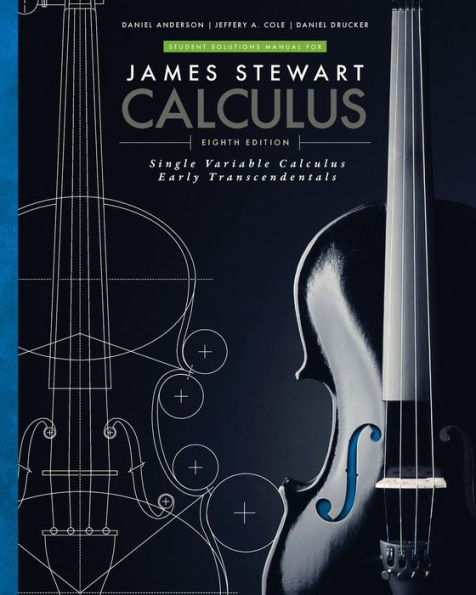Table of Contents
1. FUNCTIONS AND MODELS. Four Ways to Represent a Function. Mathematical Models: A Catalog of Essential Functions. New Functions from Old Functions. Graphing Calculators and Computers. Review. Principles of Problem Solving. 2. LIMITS. The Tangent and Velocity Problems. The Limit of a Function. Calculating Limits Using the Limit Laws. The Precise Definition of a Limit. Continuity. Review. Problems Plus. 3. DERIVATIVES. Derivatives and Rates of Change. Writing Project: Early Methods for Finding Tangents. The Derivative as a Function. Differentiation Formulas. Applied Project: Building a Better Roller Coaster. Derivatives of Trigonometric Functions. The Chain Rule. Applied Project: Where Should a Pilot Start Descent? Implicit Differentiation. Rates of Change in the Natural and Social Sciences. Related Rates. Linear Approximations and Differentials. Laboratory Project: Taylor Polynomials. Review. Problems Plus. 4. APPLICATIONS OF DIFFERENTIATION. Maximum and Minimum Values. Applied Project: The Calculus of Rainbows. The Mean Value Theorem. How Derivatives Affect the Shape of a Graph. Limits at Infinity; Horizontal Asymptotes. Summary of Curve Sketching. Graphing with Calculus and Calculators. Optimization Problems. Applied Project: The Shape of a Can. Newton's Method. Antiderivatives. Review. Problems Plus. 5. INTEGRALS. Areas and Distances. The Definite Integral. Discovery Project: Area Functions. The Fundamental Theorem of Calculus. Indefinite Integrals and the Net Change Theorem. Writing Project: Newton, Leibniz, and the Invention of Calculus. The Substitution Rule. Review. Problems Plus. 6. APPLICATIONS OF INTEGRATION. Areas between Curves. Volume. Volumes by Cylindrical Shells. Work. Average Value of a Function. Review. Problems Plus. 7. INVERSE FUNCTIONS: EXPONENTIAL, LOGARITHMIC, AND INVERSE TRIGONOMETRIC FUNCTIONS. Inverse Functions. (Instructors may cover either Sections 7.2-7.4 or Sections 7.2*-7.4*. See the Preface.) Exponential Functions and Their Derivatives. Logarithmic Functions. Derivatives of Logarithmic Functions. *The Natural Logarithmic Function. *The Natural Exponential Function. *General Logarithmic and Exponential Functions. Exponential Growth and Decay. Inverse Trigonometric Functions. Applied Project: Where to Sit at the Movies. Hyperbolic Functions. Indeterminate Forms and L'Hospital's Rule. Writing Project: The Origins of L'Hospital's Rule. Review. Problems Plus. 8. TECHNIQUES OF INTEGRATION. Integration by Parts. Trigonometric Integrals. Trigonometric Substitution. Integration of Rational Functions by Partial Fractions. Strategy for Integration. Integration Using Tables and Computer Algebra Systems. Discovery Project: Patterns in Integrals. Approximate Integration. Improper Integrals. Review. Problems Plus. 9. FURTHER APPLICATIONS OF INTEGRATION. Arc Length. Discovery Project: Arc Length Contest. Area of a Surface of Revolution. Discovery Project: Rotating on a Slant. Applications to Physics and Engineering. Discovery Project: Complementary Coffee Cups. Applications to Economics and Biology. Probability. Review. Problems Plus. 10. DIFFERENTIAL EQUATIONS. Modeling with Differential Equations. Direction Fields and Euler's Method. Separable Equations. Applied Project: Which is Faster, Going Up or Coming Down? Models for Population Growth. Applied Project: Calculus and Baseball. Linear Equations. Predator-Prey Systems. Review. Problems Plus. 11. PARAMETRIC EQUATIONS AND POLAR COORDINATES. Curves Defined by Parametric Equations. Laboratory Project: Families of Hypocycloids. Calculus with Parametric Curves. Laboratory Project: Bezier Curves. Polar Coordinates. Areas and Lengths in Polar Coordinates. Conic Sections. Conic Sections in Polar Coordinates. Review. Problems Plus. 12. INFINITE SEQUENCES AND SERIES. Sequences. Laboratory Project: Logistic Sequences. Series. The Integral Test and Estimates of Sums. The Comparison Tests. Alternating Series. Absolute Convergence and the Ratio and Root Tests. Strategy for Testing Series. Power Series. Representation of Functions as Power Series. Taylor and Maclaurin Series. Writing Project: How Newton Discovered the Binomial Series. Applications of Taylor Polynomials. Applied Project: Radiation from the Stars. Review. Problems Plus. Appendixes. A: Intervals, Inequalities, and Absolute Values. B: Coordinate Geometry and Lines. C: Graphs of Second-Degree Equations. D: Trigonometry. E: Sigma Notation. F: Proofs of Theorems. G. Complex Numbers. H: Answers to Odd-Numbered Exercises.




